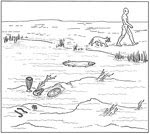 Daniel W. McShea, Perspective: Metazoan Complexity and Evolution: Is There a Trend?, Evolution, Vol. 50, No. 2 (Apr., 1996), pp. 477-492.
Daniel W. McShea, Perspective: Metazoan Complexity and Evolution: Is There a Trend?, Evolution, Vol. 50, No. 2 (Apr., 1996), pp. 477-492.[Image credit: Fig 1. Increasing complexity in evolution? McShea, 1996]
It would appear at a glance that evolution has driven increases in complexity from replicating molecules up to conscious humans. Is this justified? Or are humans simply so self-centered that we line everything up behind us, even in this modern day and age? A-Life has held the production of open-ended evolution in-silico as one of its aims for some time. Early models such as Ray's Tierra or Yaeger's PolyWorld are two of my favourite approaches to the problem. Each of these software ecosystems has spawned a complete lineage of programs addressing similar concerns. McShea's paper looks at data on real organisms and attempts to discern any trends in their evolution that would justify the belief that organisms evolve towards greater complexity. Consequently, it addresses an issue of real importance to A-Life that harks back to the formative years of Tierra and PolyWorld.
McShea's approach is firstly to clarify the kinds of complexity that can possibly be measured in real organisms. This has long been a sticking point... the real world is not always so easy to divvy up as information theoreticians might like. Useful, information-theoretic measures of organism complexity are difficult to specify. McShea simplifies matters a little by trying to count organism parts and internal processes that are specific to some groups of Metazoan. I won't go into detail here. His conclusions is interesting: we still don't know enough to say either way. He proposes an "emphatic agnosticism". This is a far cry from the usual assumption we make about complexity increase. There is room here for debate. Anyway, leaving that aside also since it still isn't the main point I want to raise in this post...
If, for some obscure reason, biological evolution turns out to be closed, could we modify the scenario in simulation to generate virtual ever-increasing complexity regardless? A-Life has always assumed that the real world offers an example of open-ended evolution and that somehow our simulations are missing some secret herbs and spices that will allow this to occur. It is pretty clear that our software evolutionary systems fall far short of biological evolution as complexity generators. We have probably missed an element or two. But could it be that we will correctly simulate real evolution and still not get open-ended evolution? Maybe the simulation will clarify our perspective on real evolution by showing us why it must be closed. What then? Could software evolutionary systems exceed nature's ability to evolve complexity?
I think that is an amazing possibility. For now I will just keep on playing "catch up" with nature.




No comments:
Post a Comment